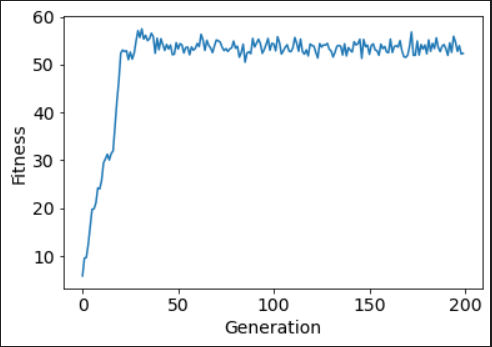本文主要是介绍遗传算法(Genetic Algorithm)之deap学习笔记(五):Santa Fe Ant Trail问题,希望对大家解决编程问题提供一定的参考价值,需要的开发者们随着小编来一起学习吧!
Santa Fe Ant Trail问题是一个经典的人工生命(Artificial Life)问题,用来探索生物群体行为和分布式智能的原理。这个问题是基于蚂蚁在寻找食物时的行为而建立的。问题中,蚂蚁在一个网格世界中寻找食物,并在回家时留下一条路径素,用于引导其他蚂蚁找到食物。蚂蚁在寻找食物和回家时,根据自身和周围信息做出决策,例如嗅觉、视觉等。
Santa Fe Ant Trail问题中,蚂蚁的行动是基于一组简单的规则,如蚂蚁在感知到食物的存在时朝食物方向移动,并在回家时遵循已有的路径素。通过这些规则,蚂蚁群体能够在整个网格世界中有效地搜索到食物,并且留下的路径素也能引导其他蚂蚁更快地找到食物。这个问题被广泛用于探索分布式智能和自组织行为的原理,也被用于设计优化算法、模拟群体行为等应用领域。
这篇博客具体讲述的问题是设计一个agent,它可以成功地引导一只人造蚂蚁沿着方形网格上的一条小径收集尽可能最多的食物,最大移动次数为600。
以下为此问题用到的蚂蚁移动的地图的.txt文件
S###............................
...#............................
...#.....................###....
...#....................#....#..
...#....................#....#..
...####.#####........##.........
............#................#..
............#.......#...........
............#.......#........#..
............#.......#...........
....................#...........
............#................#..
............#...................
............#.......#.....###...
............#.......#..#........
.................#..............
................................
............#...........#.......
............#...#..........#....
............#...#...............
............#...#...............
............#...#.........#.....
............#..........#........
............#...................
...##..#####....#...............
.#..............#...............
.#..............#...............
.#......#######.................
.#.....#........................
.......#........................
..####..........................
................................以下为构建蚂蚁移动的函数
import copy
import random
import numpy
import pygraphviz as pgv
from functools import partialfrom deap import base
from deap import creator
from deap import tools
from deap import gpclass AntSimulator(object):direction = ["north","east","south","west"]dir_row = [1, 0, -1, 0]dir_col = [0, 1, 0, -1]def __init__(self, max_moves):self.max_moves = max_movesself.moves = 0self.eaten = 0self.routine = Nonedef _reset(self):self.row = self.row_start self.col = self.col_start self.dir = 1self.moves = 0 self.eaten = 0self.matrix_exc = copy.deepcopy(self.matrix)@propertydef position(self):return (self.row, self.col, self.direction[self.dir])# 将蚂蚁向左转 90 度def turn_left(self): if self.moves < self.max_moves:self.moves += 1self.dir = (self.dir - 1) % 4# 将蚂蚁向右转 90 度def turn_right(self):if self.moves < self.max_moves:self.moves += 1 self.dir = (self.dir + 1) % 4# 将蚂蚁向前移动一格 def move_forward(self):if self.moves < self.max_moves:self.moves += 1self.row = (self.row + self.dir_row[self.dir]) % self.matrix_rowself.col = (self.col + self.dir_col[self.dir]) % self.matrix_colif self.matrix_exc[self.row][self.col] == "food":self.eaten += 1self.matrix_exc[self.row][self.col] = "passed"def sense_food(self):ahead_row = (self.row + self.dir_row[self.dir]) % self.matrix_rowahead_col = (self.col + self.dir_col[self.dir]) % self.matrix_col return self.matrix_exc[ahead_row][ahead_col] == "food"# 查看蚂蚁当前面对的方块,然后根据该方块是包含食物还是空的来执行其两个参数之一def if_food_ahead(self, out1, out2):return partial(if_then_else, self.sense_food, out1, out2)def run(self,routine):self._reset()while self.moves < self.max_moves:routine()def parse_matrix(self, matrix):self.matrix = list()for i, line in enumerate(matrix):self.matrix.append(list())for j, col in enumerate(line):if col == "#":self.matrix[-1].append("food")elif col == ".":self.matrix[-1].append("empty")elif col == "S":self.matrix[-1].append("empty")self.row_start = self.row = iself.col_start = self.col = jself.dir = 1self.matrix_row = len(self.matrix)self.matrix_col = len(self.matrix[0])self.matrix_exc = copy.deepcopy(self.matrix)最多移动600次
ant = AntSimulator(600)# 打开地图
with open("santafe_trail.txt") as trail_file:ant.parse_matrix(trail_file)添加终端以及注册进之前的蚂蚁函数
pset = gp.PrimitiveSet("MAIN", 0)def progn(*args):for arg in args:arg()def prog2(out1, out2): return partial(progn,out1,out2)def prog3(out1, out2, out3): return partial(progn,out1,out2,out3)def if_then_else(condition, out1, out2):out1() if condition() else out2()pset.addPrimitive(ant.if_food_ahead, 2)
pset.addPrimitive(prog2, 2)
pset.addPrimitive(prog3, 3)
pset.addTerminal(ant.move_forward)
pset.addTerminal(ant.turn_left)
pset.addTerminal(ant.turn_right)注册个体,适应度,详情解释可以看第一篇博客
creator.create("FitnessMax", base.Fitness, weights=(1.0,))
creator.create("Individual", gp.PrimitiveTree, fitness=creator.FitnessMax)toolbox = base.Toolbox()
toolbox.register("expr_init", gp.genFull, pset=pset, min_=1, max_=2)
toolbox.register("individual", tools.initIterate, creator.Individual, toolbox.expr_init)
toolbox.register("population", tools.initRepeat, list, toolbox.individual)#toolbox.register("select", tools.selTournament, tournsize=7)
toolbox.register("select", tools.selDoubleTournament, fitness_size = 7, parsimony_size = 1.4, fitness_first = True, fit_attr='fitness' )
toolbox.register("mate", gp.cxOnePoint)
toolbox.register("expr_mut", gp.genFull, min_=0, max_=3)
toolbox.register("mutate", gp.mutUniform, expr=toolbox.expr_mut, pset=pset)evaluation函数
def evalArtificialAnt(individual):routine = gp.compile(individual, pset)ant.run(routine)return ant.eaten,toolbox.register("evaluate", evalArtificialAnt)# 把min,max等也注册
stats_fit = tools.Statistics(lambda ind: ind.fitness.values)
stats_size = tools.Statistics(len)
stats = tools.MultiStatistics(fitness=stats_fit, size=stats_size)
stats.register("avg", numpy.mean)
stats.register("std", numpy.std)
stats.register("min", numpy.min)
stats.register("max", numpy.max)主题程序
logbook = tools.Logbook()
pop = toolbox.population(n=500) ## 迭代200次
NGEN, CXPB, MUTPB = 200, 0.2, 0.2fitnesses = list(map(toolbox.evaluate, pop))
for ind, fit in zip(pop, fitnesses):ind.fitness.values = fitfor g in range(NGEN):print("-- Generation %i --" % g)offspring = toolbox.select(pop, len(pop))offspring = list(map(toolbox.clone, offspring))for child1, child2 in zip(offspring[::2], offspring[1::2]):if random.random() < CXPB:toolbox.mate(child1, child2)del child1.fitness.valuesdel child2.fitness.valuesfor mutant in offspring:if random.random() < MUTPB:toolbox.mutate(mutant)del mutant.fitness.valuesinvalid_ind = [ind for ind in offspring if not ind.fitness.valid]fitnesses = map(toolbox.evaluate, invalid_ind)for ind, fit in zip(invalid_ind, fitnesses):ind.fitness.values = fitNeval = len(invalid_ind)pop[:] = offspringrecord = stats.compile(pop)logbook.record(gen=g, evals=Neval, **record)print("-- End of evolution --")把图画出来
import matplotlib.pyplot as plt
%matplotlib inlinegen = logbook.chapters['fitness'].select("gen")
_min = logbook.chapters['fitness'].select("min")
_max = logbook.chapters['fitness'].select("max")
avgs = logbook.chapters['fitness'].select("avg")
stds = logbook.chapters['fitness'].select("std")plt.rc('axes', labelsize=14)
plt.rc('xtick', labelsize=14)
plt.rc('ytick', labelsize=14)
plt.rc('legend', fontsize=14)fig, ax1 = plt.subplots()
line1 = ax1.plot(gen, avgs)
ax1.set_xlabel("Generation")
ax1.set_ylabel("Fitness")#line2 = ax1.plot(gen, _min)
#line3 = ax1.plot(gen, _max)
找到最佳个体
indv = tools.selBest(pop, 1)[0]
print(indv)toolbox.evaluate(indv)以下为用树画出来的这个问题的整个流程
nodes, edges, labels = gp.graph(indv)tree = pgv.AGraph()
tree.add_nodes_from(nodes)
tree.add_edges_from(edges)
tree.layout(prog="dot")for i in nodes:n = tree.get_node(i)n.attr["label"] = labels[i]from IPython.display import ImagetreePlot = tree.draw(format='png', prog='dot')
Image(treePlot)
以上就是人工蚂蚁问题的完整代码了,如果有问题可以随时问我,谢谢。
这篇关于遗传算法(Genetic Algorithm)之deap学习笔记(五):Santa Fe Ant Trail问题的文章就介绍到这儿,希望我们推荐的文章对编程师们有所帮助!






